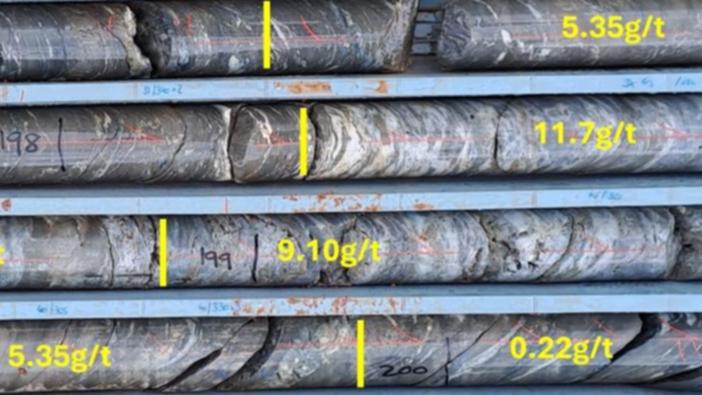Brightstar Resources has recorded a best hit of 20.39m at 3.03g/t gold in final assays from last year’s diamond drilling campaign at its Jasper Hills gold project in WA’s Eastern Goldfields.
The full hole tells a more interesting tale with a 6.42m intercept at 2.7g/t from 184.88m preceding the headline hit. The bigger intercept includes 1.36m at 9.23g/t gold from 198.21m and 2.34m at 7.72g/t gold from 205.53m.
The 13-hole combined reverse circulation (RC) and diamond coring program was designed to evaluate areas around the $3000 optimised pit shell at Brightstar’s Lord Byron deposit, within its Laverton hub. The program included infill drilling in deeper parts. It aimed to increase the company’s confidence in its geological interpretation before an imminent update to its mineral resource estimate.
The diamond drilling program totalled 13 drill holes, including seven diamond tails to extend previous 2024 RC drill holes for a total of about 1700m of coring. Brightstar now has all the resulting assays at hand.
The additional benefit of the deep diamond coring means that sound rock material was brought to surface to provide the best possible metallurgical and geotechnical media for mine and process planning.
The headline 20.39m hit intercepts the main Lord Byron mineralised body less than 20m below the $2500 optimised pit floor and is the highest intercept inside the $3000-shell.
It adds further support to the continuity of mineralisation in the body over about 40m down-dip to the current deepest three intercepts in another hole further down-dip.
The hole with the deeper intercepts was collared off section but at depth it intercepts the same section as the headline hit.
The three deep gold intercepts gave up 7.8m grading 4.07g/t, including 1m at 10g/t gold from 238.5m, 3.6m assaying 1.21g/t and 4.4m going 2.28g/t from 264m gold at the bottom of the shell. Current interpretations indicate the body might bifurcate near the design pit floor.
A new hole around the middle of that 40m no-man’s-land between intercepts and a second one about 40m below the pit floor will determine if the apparent bifurcation is real.
Four other diamond holes also provide encouraging results with primary intercepts in the range of 13m to almost 23m with average grades between 1.56g/t and 2.53g/t gold. Three intercepts are spiced up with 0.3m, 0.6m and 2.7m intercepts assaying 17.3g/t, 10.3g/t and 5.83g/t gold respectively.
The company says the results define consistent high-grade, south-plunging shoots offering excellent targets for the potential enlargement of the pit shells and underground mining considerations.
These highly encouraging results reinforce Lord Byron’s position as a significant gold resource within the company’s portfolio. The increased geological understanding and additional metallurgical and geotechnical data will contribute to updated development studies at our Laverton hub. The results highlight wide intervals of open-pit mineable gold grades, including discrete zones of high-grade mineralisation identified near the base of and below a $3,000/ounce optimised pit shell generated during a 2024 scoping study.
The Lord Byron mineralisation is hosted by a package of amphibolite and banded iron units, which are cross-cut by the northwest-trending Bicentennial shear zone, a 100m-wide zone of shearing which hosts the deposit’s main zone.
Additional mineralisation can also be identified in supergene lodes and as primary gold in the banded iron units that have been deflected and truncated by the Bicentennial shear structure.
Assay results have further defined several south-plunging, high-grade shoots in the main zone of mineralisation at the deposit within the Bicentennial shear.
Within the deposit’s 800m strike, the longitudinal section shows that the main zone extends for more than 200m along strike, and plunges at about 45 degrees. It orientation is mirrored by two other shorter mineralised zones to its southeast, with one extending about 100m and the about 30m along strike respectively.
All three zones are open at depths below about 220m below surface. Other recent drilling results point to their likely strong potential for depth continuity below the current pit shells.
These observations augur well for future possible pit deepening and cutbacks, including consideration of possible underground mining.
As always, such projections to depth are tricky when the final arbiter is the gold price. While the yellow metal’s meteoric performance shows no sign of abating, it doesn’t hurt to bring future resource opportunities to mind, especially with higher grades showing up at depth.
Brightstar is now planning additional drilling at Lord Byron later this quarter to target the main shoots at depth in advance of assessing its potential for future open pit cutbacks or underground mining below the planned open pit.
Is your ASX-listed company doing something interesting? Contact: matt.birney@wanews.com.au
https://thewest.com.au/business/bulls-n-bears/brightstar-hits-high-grade-gold-in-final-assays-from-latest-wa-drilling-c-17624126


